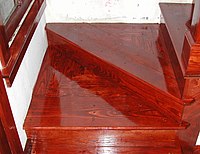
Photo from wikipedia
Background This study evaluated the effects of several epoxy resin-based sealer compositions (AHP, AH Plus; ADS, Adseal; SPL, Sealer Plus) on bond strength and intratubular dentin penetration of the endodontic… Click to show full abstract
Background This study evaluated the effects of several epoxy resin-based sealer compositions (AHP, AH Plus; ADS, Adseal; SPL, Sealer Plus) on bond strength and intratubular dentin penetration of the endodontic obturation, in root canal previously treated with calcium hydroxide intracanal medication (CH) and removed by continuous ultrasonic irrigation (CUI). Material and Methods Forty-five maxillary canines were prepared up to F5 (ProTaper system), filled with CH, coronally sealed, and stored at 37ºC. After 1 week, CH was removed using 2.5% sodium hypochlorite energized by CUI. The specimens were randomly distributed in three groups (n=15) and root canal obturated, according to epoxy-based resin sealer composition (AHP, ADS or SPL). The roots were transversally sectioned in cervical, middle, and apical thirds. In each radicular third, push out bond strength using universal machine and intratubular dentin using confocal laser scanning microscopy (CLSM) and Image J Program were evaluated. Bond strength and intratubular dentin penetration were statistically evaluated by ANOVA one-way and Tukey tests and Kruskal Wallis test, respectively (α = 0.05). Results In middle and apical thirds, AHP showed higher bond strength values (p<0.05), and ADS and SPL were similar each other (p>0.05). All epoxy resin-based sealers presented similar intratubular dentin penetration, independently of the radicular thirds (p>0.05). Cohesive and mixed failures were predominant in the cervical thirds. In the middle and apical thirds, AHP showed more cohesive type failures, while ADS and SPL showed more adhesive-type failures. Conclusions AHP has the highest bond strength in middle and apical radicular thirds, after calcium hydroxide intracanal medication removal using continuous ultrasonic irrigation, although intratubular dentin infiltration being similar among epoxy resin-based sealer with several chemical composition. Key words:Continuous ultrasonic irrigation, endodontic sealers, epoxy resin-based sealers, root canal obturation.
Journal Title: Journal of Clinical and Experimental Dentistry
Year Published: 2021
Link to full text (if available)
Share on Social Media: Sign Up to like & get
recommendations!